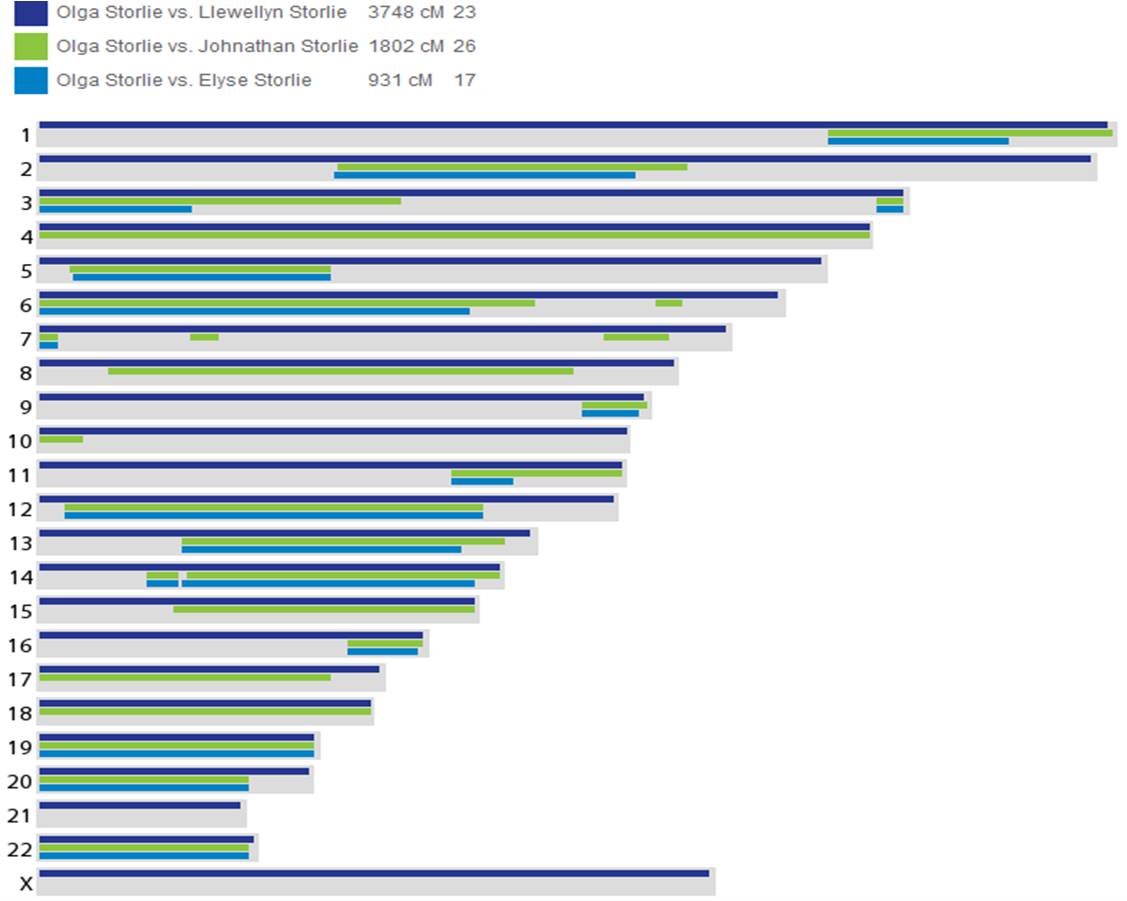Let us take a look at how inheritance works, using ACTUAL data from my family as an example. No, this is not hypothetical data inferred from studying bacteria, but actual data from my family’s tests. My father, Llewellyn, inherited one of each of his 22 autosomal pairs as well as his single X chromosome, from his mother, my grandmother Olga. On the family inheritance section of 23andme.com this is represented by the following image. The autosomes (the chromosomes numbered below as 1-22) are made up of paired strands, one from a person’s father and one from a person’s mother. When a person produces an egg or a sperm cell, that person’s top and bottom strands get cut and respliced to the other strand in a process known as homologous recombination (see generic Homologous Recombination figure).
Homologous recombination
Deck of Cards Analogy
To conceive a person, each parent’s genetic deck of cards is reshuffled, cut in two, and then each half-deck is combined with the other parent’s half deck during conception. This happens the next generation again, resulting in another cut deck. Thus, while Olga shares 1/2 of her genes with her son Llewellyn, she shares 1/4 with me (Llewellyn’s son) because 1/2 of 1/2 is 1/4.
We can see from my family’s data (Family Inheritance: Advanced View Figure) below that homologous recombination happens about once or twice for each chromosome, but occassionally there is no recombination event on a particular chromosome (you can see that recombination didn’t occur on some of the chromosomes for some of the generations below). For the most part though, each single strand in each of your sperm or egg cells is made up of a reshuffled combination of both your parents’ strands, usually once or twice for every chromosome, resulting in a modest reshuffling of the genetic hand rather than a complete blending of the DNA. Thus, in my father, Llewellyn, the DNA strands that he inherited from my grandfather (not shown because he died before I could get him tested) and my grandmother (Olga) reshuffled randomly before they separated to make the male gamete (sperm) cells, one of which went into my mother’s egg resulting in my conception. I have half of my dad’s autosomal DNA, or about a quarter of my grandmother’s DNA. The three images below are taken from our 23andme results.

Since I inherited my X chromosome from my mother’s egg, I didn’t inherit Olga’s X. Therefore, I could say even prior to receiving my results that my daughter Elyse could not have inherited my grandmother Olga’s X chromosome.

We can see from the chart (Family Inheritace: Advanced View II) that Elyse is genetically about an eighth of her great grandmother Olga. The areas in light blue on the chart are areas on the chromosome where Elyse shares an identical stretch of DNA with her g-grandmother. These occur on all the 23 chromosomes shown except for 8, 10, 15, 17, 18, 21, and the X chromosome (as previously mentioned). Again, each of these chromosomes is made up of two strands–one received from the person’s mother and and one from the father–that make up the 23 chromosomal pairs shown below. The chromosomes have 3 possible colors: dark blue, light blue, or white corresponding to whether or not the sharing is in two, one, or none of the strands of the homologous pair within a chromosome. If two identical twins were tested, the colored areas would all be dark blue, indicating 100% identity over the areas tested.

All living descendants of my grandmother would share at least some similar strands of DNA for many generations. Thus, if a person has enough offspring, all of their DNA will be preserved in the bodies of their descendants. In fact, if your descendants continue to multiply exponentially, so will your own DNA. If your descendants all choose to have fewer than 2 children each, your DNA will eventually vanish, unless you have enough siblings and cousins who share your DNA and pass it down through their descendants. On the basis of this, one can use genetic tests to identify virtually all your cousins in the world. I used this to identify over 1100 of my relatives as of March 2013.
Eventually, software will interface with geni.com, ancestry.com, and databases like our’s to verify connections and link all human beings in one giant world family tree. Using that tree, we will see how we connect to the Giants of the Earth of the past, and perhaps realize how the things we do today impact the opportunities and freedoms of those born in the future. Perhaps when we recognize that we sentient beings are a link in a delicate chain of existence, we might experience the gravity of the call of existential stewardship and become Giants of the Earth for our age.



